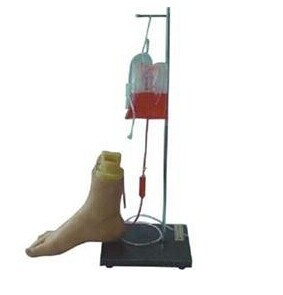Foot intravenous injection is an important technique in clinical care and emergency medicine, especially when patients are unable to use the conventional site of intravenous injection, the foot becomes a backup option. Although the operation of foot intravenous injection is relatively simple, due to the particularity of the anatomical structure and the individual differences of different patients, the operation requires high skills and strain ability. For medical students, when learning this skill, how to cope with emergencies in a high-pressure environment has become an important consideration to improve their clinical resilience. As a high simulation tool, whether foot intravenous injection model can effectively improve students' clinical resilience has become an important topic in the field of medical education.

Foot intravenous injection model
Role of clinical resilience and foot intravenous injection model
Clinical resilience refers to the ability of healthcare professionals to quickly assess, make decisions and implement effective responses in the face of complex, sudden and non-standard clinical situations. For medical students, the development of this ability is crucial, especially in the initial stage of clinical training. However, traditional theoretical learning and classroom explanation often fail to fully simulate real clinical pressure and complex situations. Therefore, practical training with high simulation teaching model is an effective way to improve students' adaptability.
The advantages of high simulation training and data support
The advantage of the foot intravenous injection model is its ability to simulate the anatomical differences of the foot in different patients and the various complexities of the puncture operation. Through repeated practice, students can master the operation skills in various situations and improve their ability to react quickly and deal with complex situations. Industry experts point out that the use of high simulation models not only helps students improve the accuracy of intravenous injections, but also allows them to remain calm and make effective decisions in the face of complex situations.
A 2022 study of the effects of medical simulation training found that students who trained with a foot intravenous model were 18% better at responding to emergency situations and 22% better at operating success. In addition, the students' confidence and decision-making ability in the actual clinical operation were also enhanced after the simulation training, and they were able to more accurately judge and deal with common problems such as puncture failures and vascular positioning difficulties.
Personal growth effects of model training
For medical students, foot intravenous injection model training is not only a technical ability training, but also an important part of personal growth. In the traditional teaching mode, students often lack the situational simulation when facing real patients, which is easy to generate fear and uncertainty in the tense clinical environment. Through repeated training of the model, students can gradually adapt to complex clinical situations, cultivate strong psychological qualities, and enhance their self-confidence in dealing with emergencies.
Conclusion
As a high simulation tool, foot intravenous injection model can not only help medical students master operational skills, but more importantly, it provides students with a low-risk environment to develop their clinical resilience. By simulating different clinical situations, students can improve emergency response speed and operational accuracy, and be more relaxed in the face of emergencies. In addition, data and studies by industry experts have shown that the foot IV model can significantly improve students' clinical confidence and decision-making skills, providing strong support for their future clinical practice. Therefore, the foot intravenous injection model not only plays an important role in skill training, but also plays a positive role in the personal growth and career development of students.
